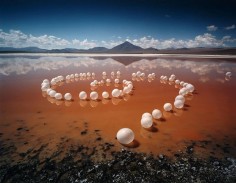SCARLETT HOOFT GRAAFLAND
vanishing traces
source: michaelhoppengallery
Born in the Netherlands in 1973, Hooft Graafland is currently based in Amsterdam. She has studied at the Royal Academy of Fine Arts, The Hague, Bezalel Academy, Jerusalem and Parsons School of Design, New York and has travelled to Iceland, Israel, Canada and the United States for her work. Her work has been exhibited in solo exhibitions all over Europe and as part of group shows at the Metropolitan Museum, New York, and the Musée D’Orsay, Paris amongst others.
Inhabiting the border between straight photography, performance and sculpture, Hooft Graafland’s photographs are records of her highly choreographed live performances in the salt deserts of Bolivia, the Canadian and Finnish Arctic, and rural China. Fascinated by the surreal beauty of the harsh natural landscape she utilises this as her canvas. Anthropologically curious, her ideas emerge directly from the local mythology that originates in this otherworldly environment.
Using naïve and childlike colour palettes her photographs draw on the language of the surreal, showing familiar objects out of context (a llama wearing balloons, top hats flying through the desert and a pair of naked legs entwined around a cactus). Her humorous and unsettling juxtaposition of these everyday objects with the sparse, unforgiving landscape echoes the aesthetic of surrealists such as René Magritte. Hooft Graafland utilizes the medium of photography, associated with the representation of truth, to illustrating the fantastic and the irrational.
‘Vanishing Traces’, a homage to land artist, Robert Smithson, is made out of floating balloons at Laguna Colorada in southern Bolivia. Smithson was inspired to make his original piece after reading about this particular red salt lake (Laguna Colorada) in the book ‘Vanishing Traces of Atacama’ by William Rudolph. Due to the remoteness of the location however, Smithson installed his work in the Great Salt Lake in Utah. Hooft Graafland has returned to the place of his inspiration, with her team, to build her own transient spiral balloon jetty. The clean simplicity of her finished works offer no indication of the difficulties in accessing and working in such inhospitable terrains. Highly dependant on the collaboration of the local people, her journeys are indebted to the assistance of the local people and artists with which she works.
.
.
.
.
.
.
.
source: artslant
In the work of Dutch artist Scarlett Hooft Graafland you find a combination of straight photographic practice with performance and sculpture in which she constantly refers to a more profound cultural discourse of her surroundings. She made extensive travels to various parts of the world to work on projects, such as in the highlands of Bolivia, the south of China, the arctic Canada and the Palestinian Westbank. In these site-specific installations and photo set-ups she would make use of local materials, traditions or techniques. Most recently she is having a soloshow at Michael Hoppen Contemporary gallery in London and a duo show with Jan Bünnig at Autocenter, Berlin and she will participate in the exhibition ‘Slow Art’ at Nuke Gallery in Paris, opening the 20st of February.
Hooft Graafland graduated from the Royal Academy in The Hague, The Netherlands, studied for one year at the post-graduate program at Bezalel Academy in Jerusalem and graduated in 2002 from a MFA in sculpture at Parsons School of Design, New York.
.
.
.
.
.
.
.
source: shft
In the Netherlands, where Scarlett Hooft Graafland grew up, every inch of land is either urbanized or cultivated; there is no “natural” landscape left. That may help explain her fascination with wild, unforgiving landscapes, where she travels to shoot her signature surreal photos that explore the fertile area where the manmade and the natural intersect.
From Bolivia’s altiplanos to the Arctic tundra, Hooft Graafland intervenes in harsh environments to create strange, captivating images that marry photography with performance and installation. The works carry a subtle, underlying message about human impact on the natural world.
Asked about her attraction to desolate places, the artist told Don’t Panic:
“I am mostly interested how local people survive who live in such harsh circumstances – the Inuit in the extreme cold, endless winters on the one hand, and also these Bolivians who live in the Altiplano in the highlands of Bolivia. On the borders of the salt desert, it seems almost impossible to be able to make a living. I like to experience nature as such a strong force. We humans might think we ‘rule the world’ but at the end of the day we are just a tiny fraction.”


